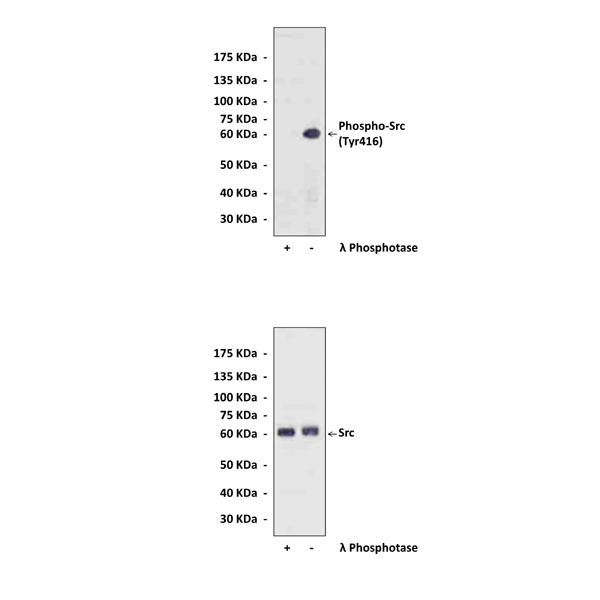Product Sheet CC1034
Description
BACKGROUND Src was the first protooncogene described, and was among the first molecules in which tyrosine kinase activity was documented. The Src gene family has nine known members (Blk, c-Fgr, Fyn, Hck, Lck, Lyn, c-Src, c-Yes and Yrk), each encoding a cytoplasmic protein-tyrosine kinase (PTK) believed to be involved in signal transduction. The Src PTKs contain three domains (SH1, SH2 and SH3) that are found in many other signaling proteins. The SH1 domain has PTK activity, whilst the SH2 and SH3 domains are involved in mediating protein-protein interactions by binding to phosphotyrosine-containing and proline-rich motifs, respectively. The expression patterns of the c-Src PTKs suggest that they function in a broad range of biological situations, in many cases regulating the behavior of terminally-differentiated, post-mitotic cell types.1 Src has been defined as a common modular structure that participates in much of the crosstalk between the cytoplasmic protein tyrosine kinases and tyrosine kinase receptors.2 Src has been found to be overexpressed and activated in a large number of different cancers. Cellular Src has been shown to activate a number of different effectors that are involved in different aspects of cancer biology, such as metastasis, cell cycle regulation and cell survival.3,4 Cumulative data marks Src signaling as attractive therapeutic targets in different cancers. Tyr416 of Src can be phosphorylated during the activation of Src kinase, resulting in upregulation of Src kinase activity, whereas phosphorylation of Tyr527 in the carboxy-terminal tail of Src by Csk results in inhibition of the enzyme activity.5
REFERENCES
1. Homsi J et al., Expert Opin Ther Targets. 11:91-100, 2007.
2. Brickell PM et al., Crit Rev Oncog 3:401, 1993.
3. Bolen JB et al., FASEB J 6:3403, 1992.
4. Alvarez RH et al., Cancer 107:1918, 2006.
5. Hunter T: Cell 49:1-4, 1987.
2. Brickell PM et al., Crit Rev Oncog 3:401, 1993.
3. Bolen JB et al., FASEB J 6:3403, 1992.
4. Alvarez RH et al., Cancer 107:1918, 2006.
5. Hunter T: Cell 49:1-4, 1987.
Products are for research use only. They are not intended for human, animal, or diagnostic applications.
Details
Cat.No.: | CC1034 |
Antigen: | Sequence surrounding and including Tyr416 of human Src sequence. |
Isotype: | Affinity Purified Rabbit IgG |
Species & predicted species cross- reactivity ( ): | Human, Mouse, Rat |
Applications & Suggested starting dilutions: | WB 1:1000 IP n/d IHC (Paraffin) n/d ICC n/d FACS n/d |
Predicted Molecular Weight of protein: | 60 kDa |
Specificity/Sensitivity: | Detects human, mouse and rat Src proteins. Due to sequence identity, it also reacts with all other Src family members when their Tyr416 counterparts are phosphorylated. |
Storage: | Store at 4° C for frequent use; at -20° C for at least one year. |
*Optimal working dilutions must be determined by end user.
Products
| Product | Size | CAT.# | Price | Quantity |
|---|---|---|---|---|
| Polyclonal Src, Phospho-Tyr416 Antibody: Polyclonal Src, Phospho-Tyr416 Antibody | Size: 100 ul | CAT.#: CC1034 | Price: $333.00 |
Resources/Documents
Publications
2011
Gucalp, A., E. Comen, S. Redana, L. Evangelista, D. Giri, X. Zhang, S. Patil, M. Akram, L. Norton, C. Hudia, and M. Fornier. 2011. P4-16-06: Expression Patterns of Receptor Activator of Nuclear Factor-kB (RANK) and Src in a Series of Primary Breast Tumors (BT) and Bone Metastases (BM) in Patients (pts) with Metastatic Breast Cancer (MBC). Cancer Res, 71:P4-16-06.

